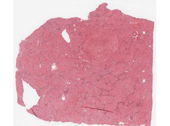Liver II Cirrhosis
Slide #3472
This 54 year old woman underwent an orthotopic liver transplant for autoimmune chronic hepatitis with cirrhosis. Her liver disease dated back three years when she presented with fatigue and abnormal bleeding. At that time her blood tests showed elevated serum aminotransferasesAST(aspartate aminotransferase) andALT(alanine aminotransferase) of 234 U/L and 303 U/L (both normal levels are <40). Her total serum bilirubin was 5.6 mg/dl (normal <1.0) and her albumin was low at 3.0 g/dl (normal >3.5). Her serum alkaline phosphatase was normal at 36 U/L (normal <110). After a comprehensive workup including serologic exclusion of chronic hepatitis B and C, as well as any history of possible chronic medication-related liver injury, a panel of autoantibodies was obtained and a striking elevation of serum anti-nuclear antibody of 1:1280 was found. A liver biopsy showed chronic hepatitis with moderate activity and developing cirrhosis.
Questions
- Examine the architecture of this section of the explanted liver. How does it compare to normal liver, and what diagnosis would you render?
- What are the predominant inflammatory cells present, and where are they located?
- If this is "autoimmune" chronic hepatitis and cirrhosis, describe the etiopathogenesis of this process.
- What other conditions may show general pathologic similarities to that seen in this case?
- What basic pathologic process does this case demonstrate?
